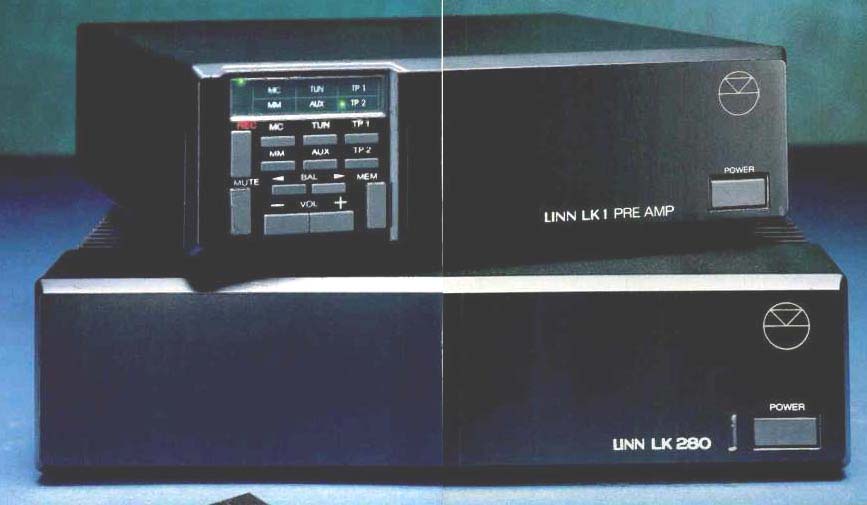
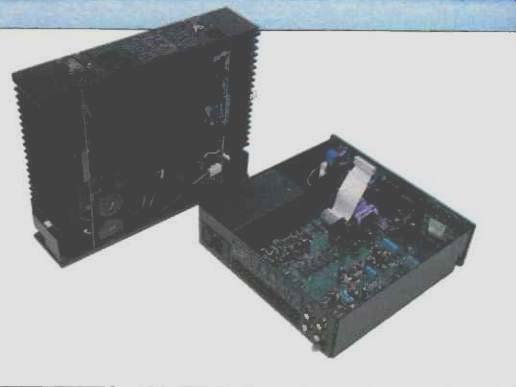
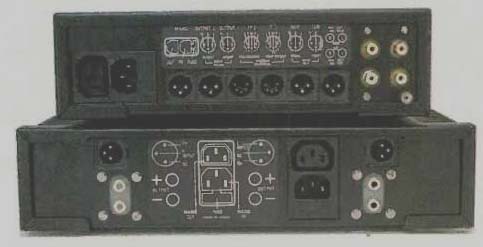
Linn LK1 Preamp
Manufacturer's Specifications:Nominal Output Level: 0.5 V rms at 1 kHz, 1-kilohm load.
Input Levels: MM phono, 5.0 mV; MC phono, 150 uV; high-level, 0.5 V rms.
Tape Output Level: 0.4 V rms, 2 kilohm load.
Dimensions: 10.24 in. W x 2.95 in. H x 10.43 in. D (26 cm x 7.5 cm x 26.5 cm).
Weight: 9.9 lbs. (4.5 kg).
Price: $1,050; remote control, $100; adaptor cables, $40 each.
Company Address: c/o Audiophile Systems, 8709 Castle Park Dr., Indianapolis, Ind. 46256.
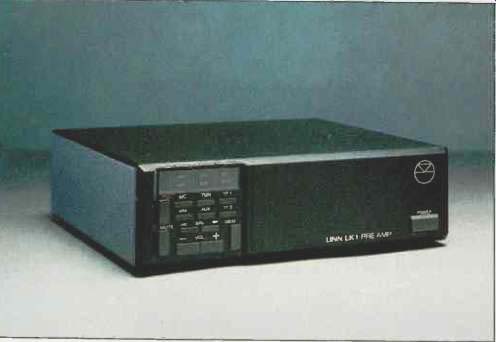
Although most of us tend to think of Linn primarily as a manufacturer of high-quality turntables, the company, based in Glasgow, Scotland, has an equally high reputation in the field of audio electronics. I had an opportunity to evaluate both their LK1 microprocessor-controlled preamplifier and companion power amplifier, the Model LK280.
Although my experiences with these two components appear here as separate reports, I would stress that the LK1 and LK280 are very definitely meant for each other, as shown by their method of interconnection (which I'll get to shortly). In fact, you would find it difficult, it not impossible, to use either of these products singly without special adaptor cables. Think of these two units, then, as an exceptionally fine integrated amplifier delivered on two chassis.
The LK1 preamplifier is of dual-monophonic construction and has inputs for tuner, auxiliary, MM or MC phono cartridge, and two tape decks. Outputs are provided for two power amps and two tape decks. Dubbing from either connected tape deck to the other is possible, and volume adjustment is performed in 256 steps using a precision resistor network. A protection system silences output during any power-supply or line-voltage transient.
Physically, the LK1 is divided into three sections: The audio board, the power supplies, and the control board. The audio board takes up most of the space inside the preamp.
All amplification, switching, and level adjustment are per formed on this board, which also contains much of the power-supply circuitry. The audio signal, from input to out put, is routed only through this board. The control board, located just behind the front panel, handles only digital control signals, as does the ribbon cable connecting it to the audio board.
The toroidal power transformer used in the LK1 is shielded in a steel case. All switching is done electronically; there are no moving parts in the preamp. Operation of the preamp can be controlled from the front panel or from an optional remote control. When a key is pressed-either on the front panel or on the remote control-a microprocessor generates the correct output commands to the audio board.
Product literature, provided by Audiophile Systems, goes into great detail concerning the circuit specifics of this product as well as of its companion LK280 amplifier. To attempt to trace the signal from input to output would re quire far more space than this report can occupy, so I will summarize key features and design objectives, as stated by the product's designers.
Microprocessor control provides not only remote-control capability but volume level presets for each input, the ability to listen to one source while recording another, and even keyboard lockout to prevent unauthorized use by children or, as the Linn brochure puts it, "during drunken orgies." (Editor's Note: Whilst I cannot publicly attest to the actual occurrence of orgies in any part of Glasgow, or even that I have personally witnessed any member of the Linn Products team take part in orgies outside of 'twixt-ear environs, I must take cognizance of certain ill-founded rumors. -E.P.) The LK1 features modular construction, extremely high r.f. rejection, a high level of immunity to external mechanical feed back, high-quality connectors, and compact dimensions.
Key design objectives, according to the designers, were the preservation of signal integrity from a moving-coil cartridge and optimization of low-noise performance (including thermal noise, digital noise, and r.f. breakthrough). Solid state switching was used to avoid long signal runs and distortion from mechanical contacts due to contact rectification, microphony, or wear. Finally, the designers sought to develop power supplies and voltage-regulation circuitry that would provide very high isolation from the a.c. line and between stages. For the most part, I would say that these objectives were achieved.
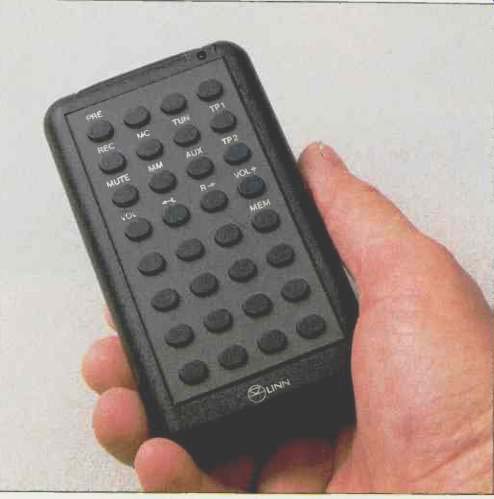
Control Layout
All user controls for the LK1 are located at the left end of the front panel, except the power switch, which is at the panel's lower right corner. There are individual buttons for "MM" and "MC" phono, "Tun," "AUX," and "Tp 1" and "Tp 2." If the nearby "Rec" button is pressed prior to pressing one of these primary-function buttons, the designated input will be routed to he tape outputs. Pressing the button labeled "Mute" after pressing "Rec" will disconnect the input from the tape outputs. Two "Bal" buttons adjust channel balance, while buttons labeled " + " and "- " are used to change volume. After selecting any input and adjusting volume and balance, the volume settings for that particular input can be stored by pressing "Rec" and then "Mute." The stored volume settings can be recalled by selecting the appropriate input and then pressing the "Mem" button.
Stored volume settings are retained by the microprocessor, which is powered by a rechargeable battery. Settings will be retained for several months, even if the power cord is disconnected. Several other combinations of buttons provide additional, if rarely used, functions such as causing balance to shift completely to one channel or the other, restoring center balance settings, and. perhaps most interesting of all, completely disabling all panel controls. This last trick is accomplished by touching "Rec" and then the volume "-" button. To cancel this lockout feature, the same buttons are touched in the same order a second time. The remote control has functions identical to those on the front panel; it is activated by pressing a button on the remote labeled "Pre." The only difference is that pressing "Rec" and then the volume "- " on the remote disables the remote without disabling the front-panel controls themselves. Several unmarked buttons on the remote, I am told, are for future use with other Linn components.
The rear panel of the LK1 has one of the most unusual layouts I have ever encountered in a preamplifier. Although the phono inputs are gold-plated phono jacks, all other inputs and outputs use three- or five-pin Cannon-type connectors. The inputs for "AUX" and "Tun" and the two outputs use three-pin connectors, while the "Tp 1" and "Tp 2" input/output receptacles use five-pin connectors. Initially, I thought that the high-level inputs and outputs might be balanced, or "floating." Such was not the case at all. For the three-pin connectors, pin 1 is used as a signal ground, pin 2 is a left input (or output), and pin 3 is a right input (or output). For this reason, you will not be able to use "standard" XLR three-pin cables but must either acquire special cables from Audiophile Systems (as I did) or wire up your own. I was loaned cables for connecting to the high-level inputs, as well as a pair of cables that enabled me to connect from the LK1 to the LK280 power amp, which has the same sort of unusual connector arrangement. As for measuring the performance of the preamp alone, I was able to do that because my Audio Precision System One test panel is equipped with XLR as well as unbalanced banana plug connectors. Since at least one of the channel outputs is wired in standard XLR fashion, I was able to check out the LK1's performance without having to tear into the supplied cables. Both channels of the LK1 are identical and completely separate, so it didn't matter at all that by connecting this "nonstandard" cable to the standard three-pin receptacle on the test equipment, the opposite channel output was being "shorted out" completely! A separate line cord is supplied with the preamp and must be connected to the appropriate socket on the rear panel. There's also an IEC Standard, auxiliary, unswitched, unfused power receptacle that can be used to connect the power cord for the LK280 or any other equipment.
Measurements
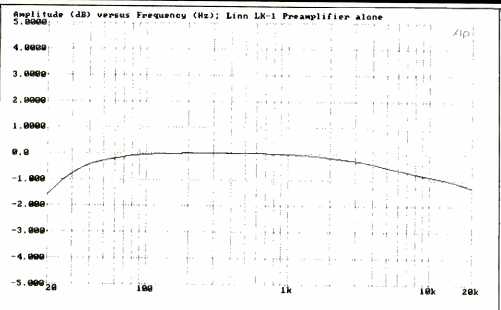
Fig. 1-Frequency response, LK1 preamp alone.
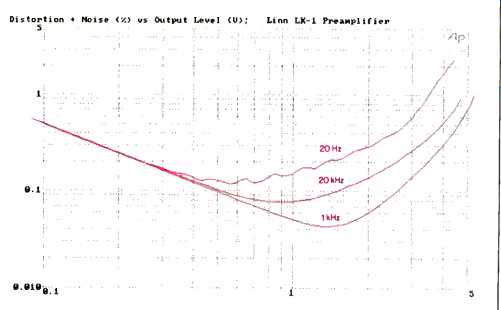
Fig. 2-THD + N vs. output voltage.
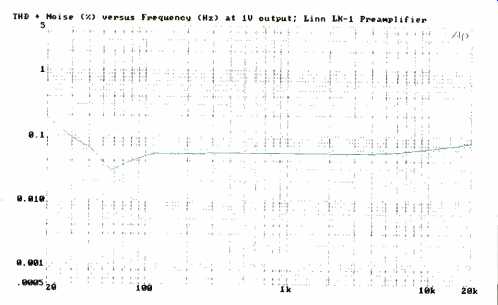
Fig. 3-THD + N vs. frequency at 1 V output.
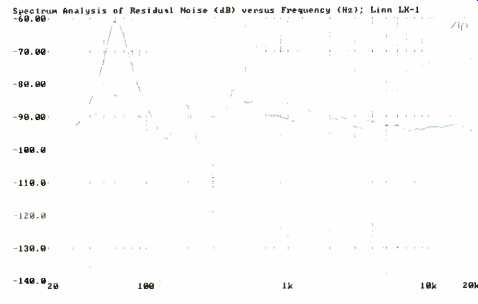
Fig. 4-Spectrum analysis of residual noise, with no input applied. Main curve
shows residual noise with LK1 preamp 2 feet from LK280 amp. The 60-Hz noise
peak was obtained when the preamp was just above the amp; see trot.
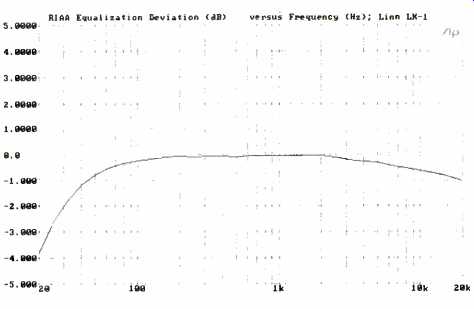
Fig. 5-Deviation from RIAA equalization, including effects of overall frequency
errors shown in Fig. 1; see text.
As you can see by examining the published specifications at the beginning of this report, Linn does not put too much stock in lab measurements. I, on the other hand, have always maintained that only an intelligent combination of lab and listening tests will reveal the true merits, or demerits, of an audio component. Therefore, I hope the folks at Linn and those readers who rely solely upon subjective judgment-will bear with me as I discuss first how the unit measured.
Overall frequency response of the preamplifier, using the high-level inputs, is shown in Fig. 1. Response was down by just over 1.5 dB at 20 Hz and by 1.2 dB at 20 kHz. This deviation from perfectly flat response is also reflected in my tests of phono frequency response and of the LK280 power amp's performance. This latter measurement had to be made using the LK1 preamp as an interface between my test equipment and the amp because of the amp's unusual input jacks.
Input sensitivity for 0.5 V output, using the AUX or tuner inputs, was 255 mV. The MM phono inputs required 2.4 mV, at 1 kHz, to produce the same output level, and the MC inputs required only 215 uV for 0.5 V at the main outputs.
Figure 2 shows THD + N versus output level at three test frequencies. At 1 V output, THD + N was 0.05% for a 1-kHz test signal, 0.16% for a 20-Hz signal, and 0.08% for a 20-kHz signal. Maximum output level for the preamp, before reaching gross levels of distortion, was about 5 V. A continuous plot of distortion versus frequency for a fixed output of 1 V (Fig. 3) pretty well confirmed the results of Fig. 2.
S/N ratio for the high-level inputs measured 77.5 dBA, using a standard input of 0.5 V and with the volume control adjusted to deliver the standard reference output of 0.5 V.
S/N for the MM phono inputs, referred to the same output level and to an input of 5 mV, was 76.7 dBA-almost as good as for the high-level inputs. Even more amazing was the S/N for the MC phono inputs, which was 76 dBA using an input reference level of 500 µV.
I was quite satisfied with all of these results, but some time later, for confirmation, I decided to run a spectrum analysis of the residual noise to see at what frequencies most of the noise was occurring. By the time I got around to doing this, the LK280 power amp, which was sitting beneath the LK1 on my test bench, had been left on following some listening tests of the two units. Much to my surprise, in running the spectrum analysis, I was shocked to discover a noise peak at the power-line frequency of 60 Hz that was barely 60 dB below reference level. I realized that this analysis was made without A-weighting, but it still seemed too great a difference between my overall reading of 77.5 dB and the "hum" peak seen in Fig. 4.
Referring to the owner's manual, I came across the following note: "The power amp should be at least 15 cm (6 inches) from the preamp to avoid hum." Sure enough, when I turned off the power amplifier and repeated the spectrum-analysis sweep, the previous peak receded by nearly 25 dB! This second plot, also shown in Fig. 4, should remind prospective owners of this Linn combination how important that note in the manual is. The new plot made more sense in light of the overall S/N results obtained earlier.
I was a bit disappointed with the results I obtained for phono overload. If you are going to use this combination to play records, I would recommend that you use a high-quality cartridge which delivers relatively low output voltage (whether you use an MM or MC cartridge). MM phono overload measured 65 mV, and overload for the MC inputs occurred at a level of 6 mV. In both cases, a 1-kHz signal was used. Incidentally, although it is possible to connect and use both an MM and an MC cartridge with the LK1, the two inputs share a common equalization stage. It will there fore not be possible to listen to the MC cartridge output while recording from the MM cartridge, or vice versa.
Figure 5 shows how much the overall phono frequency response, via either the MM or MC inputs, deviates from the RIAA equalization curve. I should point out that the error at the treble end of the plot is almost entirely due to the high-frequency roll-off previously measured for the high-level inputs (see Fig. 1). At the base end, subtracting the low-frequency roll-off previously obtained would leave an equalization error of only about 2 dB--and this is not really an error. European manufacturers subscribe to the IEC version of low-frequency equalization--a gentle roll-off below 30 Hz--that the U.S.-based RIAA stubbornly refuses to adopt.
Had I used the IEC version of the reciprocal curve, the deviation at the low end would have been off, but only by the same 1.5 dB measured earlier for the high-level inputs.
Of course, since this preamp has no tone controls, there is no way to correct the errors in frequency response for any of the inputs without hooking in a high-quality equalizer via one of the tape-monitor loops. For most listeners, I suspect that the minimal error in response is not serious enough to worry about. After all, it is less than 0.5 dB at 40 Hz, and very few speaker systems are "flat" below this to begin with.
Use and Listening Tests
It took me no time at all to become accustomed to the simple, but elegant, microprocessor-controlled switching facilities of the front panel of the LK1. I detected absolutely no spikes or noise when switching from one program source to another, nor could I detect any audible crosstalk when directing one program source to the LK280 amplifier while another was being fed to the tape outputs. All in all, the LK1 is an unencumbered preamplifier that should gladden the hearts of purists--especially those who elect to couple it to the LK280, as I did for my serious listening tests. Accordingly, I'll discuss my reactions to the sound quality at the end of the report dealing with this companion component.
-Leonard Feldman
Linn LK280 Power Amplifier
Manufacturer's Specifications:
Power Output: 80 watts per channel into 8 ohms. 160 watts per channel into 4 ohms.
Voltage Gain: 26 dB.
Input Impedance: 3 kilohms.
Dimensions: 12.6 in. W x 2.95 in. H x 10.4 in. D (32 cm x 7.5 cm x 26.5 cm).
Weight: 19.8 lbs. (9 kg).
Price: $1.495.
Company Address: c/o Audiophile Systems, 8709 Castle Park Dr., Indianapolis, Ind. 46256.
The Linn LK280 power amplifier, intended to be used with that company's LK1 preamp, is the successor to Linn's earlier LK2. It features higher power output than the earlier model (80 watts per channel into 8 ohms, as opposed to 60 watts) and a host of other improvements and refinements. In passing, I must point out that,-although I appreciate and understand Linn's reluctance to include in the owner's manual or publish any more revealing specifications than those shown, here in the U.S., we do have to contend with the FTC power rule, for better or worse. This rule requires that for amplifiers intended for consumer use, the manufacturer must list not only the unit's rated power and the impedance at which it can be achieved, but also the frequency band width over which the rated power can be delivered and the maximum harmonic distortion likely to occur at any frequency up to the rated power level. Clearly, those last two specification requirements are not being met by Linn, and I would urge the American importer, Audiophile Systems, to revise their literature to correct that omission. This amplifier is just too good a product to be troubled by such a small thing.
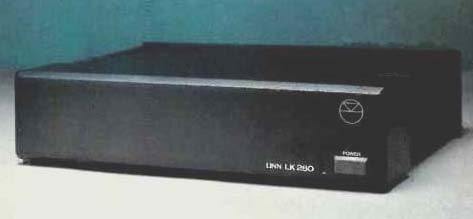
As is true of the LK1 preamp, the LK280 features modular construction, immunity to r.f. and mechanical feedback, high-quality connectors, and compact size. The LK280 is actually a dual-mono amplifier, although both channels are powered by a single, toroidally wound transformer. Separate secondary windings are used for each channel, and the main filter capacitors in each channel have a value of 10,000 uF. The massive shielded transformer takes up a good deal of the amp's interior volume, while two identical, modular, audio amplifier channels are mounted vertically on either side of the centrally located transformer housing, close to the heat-sinks.
A detailed circuit description supplied by Audiophile Systems revealed some of the design philosophy embodied in this amplifier. The LK280 has no circuitry for sensing the temperature of the output transistors; its design eliminates the need for adjusting the quiescent current in the output stages as device temperatures change. Further, it has no current-limiting circuits; instead, it is protected against failure by a line fuse. In addition, a sensing circuit responds to any potentially damaging conditions-such as an excessive static current drain or a high-level transient-by shutting down after only a few milliseconds. When such a shutdown occurs (it never did during my preconditioning and other bench tests), the only way to restore operation is to turn the amplifier off for at least five minutes and then turn it back on.
Unlike the earlier LK2, all protection and regulator control circuitry is now contained on a custom-made, thick-film hybrid microcircuit.
Control Layout
The LK280 has no controls other than a power switch and a nearby green power indicator light which is visible only if you are at eye-level with the front panel. The rear panel, on the other hand, is unlike that of any power amp I have ever tested. Instead of using ordinary phono input jacks, signals from the companion LK1 preamplifier are applied to the LK280 via three-pin connectors. Special interconnect cables, supplied with the LK1, link the amplifier with the XLR connectors on the preamplifier. For the left channel, pin 2 is the "hot" signal pin, pin 3 has no connection, and ground return is via pin 1. For the right channel, pin 3 carries the audio signal, with no connection at pin 2. For this reason, standard XLR cables cannot be used, though adaptor cables with RCA plugs at one end are available from Audiophile Systems. Not having these, I fed signals via the LK1 preamp in order to measure the amp's performance. A more direct approach would have involved either destroying the obviously expensive cables supplied with the preamp or stopping to buy XLR plugs and then fabricating new cables.
The speaker output terminals resemble banana-plug sockets, but they are not spaced to accommodate standard double-banana plugs and are too small for normal bananas to fit. (Audiophile Systems says they're deliberately under sized to provide a very tight fit, but I couldn't get regular bananas into them.) Linn provides four color-coded banana plugs, each having a spring-loaded wire along one side, instead of the usual four spring leaves. These plugs must be soldered to your speaker-cable conductors. Audiophile Systems says they would hope that the dealer would take care of this. However, I've noted that European manufacturers, especially those from the U.K., seem to thrive on making their customers buy and use soldering irons. I suppose it gives the user a sense of involvement in the installation process that is not possible if all you have to do is feed a stripped wire neatly into a hole that is exposed when a binding post is loosened! I will admit that once the soldering task was completed, the friction fit of Linn's special plugs made far better contact than would be obtained with most banana plugs.
The separately supplied power cord must be plugged into a corresponding three-terminal receptacle on the rear of the amplifier. There is an additional a.c. convenience receptacle configured in accordance with IEC Standards, as well as a fuse-holder. Since the fuse contained in this holder is an important amplifier protection device, care must be taken to assure that its value is correct. When the amp is used in Europe (at 220 or 240 V), the proper fuse value is 3.15 amperes, slow-blow--or anti-surge, as the "mother country" calls it--while for U.S. use (at 120 V), the value should be doubled to 6.3 amps, slow-blow.
Measurements
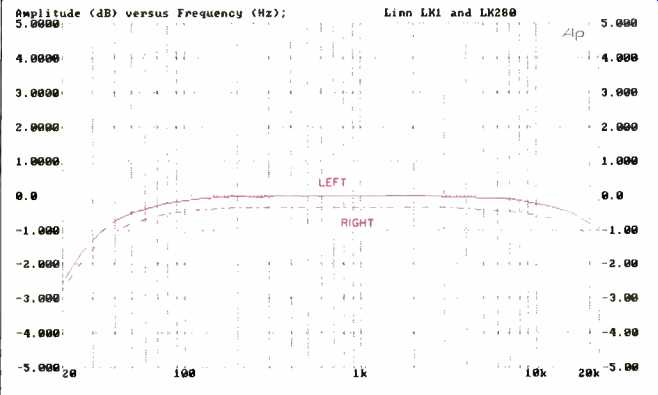
Fig. 1-Frequency response, Linn LK280 amplifier and LK1 preamp; (see text).
Right channel has been displaced for clarity.
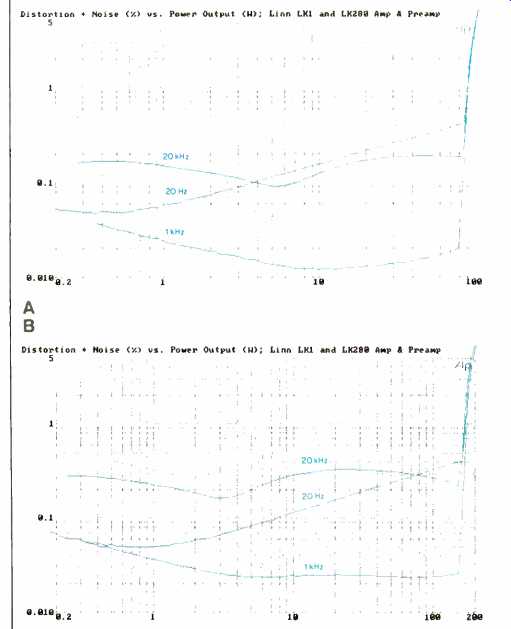
Fig. 2--THD + N vs. power output per channel for 8-ohm loads (A) and 4-ohm
loads (B).
Figure 1 shows the frequency response of the LK1 and LK280 combination, not that of the amp alone. You can derive the amp's response by comparing Fig. 1 with the response curve for the preamp alone (see accompanying test report). It is possible to conclude that, if anything, the amp's response at 20 kHz is up a fraction of a dB, since the response of the LK1 at this frequency was down a bit more than 1 dB. At 20 Hz, however, the response of the amp alone is actually down about 1 dB, since the preamp's response was down some 2.5 dB at this frequency. The dashed curve of Fig. 1 is the response of the right channel; this curve has been deliberately displaced for clarity.
Figure 2A shows how THD + N varied as a function of output power when the amp was connected to 8-ohm loads.
For a 1-kHz test signal, THD + N for the preamp/amp combination was only 0.03% at the rated output of 80 watts per channel. For a 20-kHz signal, THD + N was just under 0.2%, and for a 20-Hz signal, it was just over 0.4%-both at rated output. So, to conform to FTC regulations, Linn would have to elaborate on their 80-watt rating by additionally specifying a THD rating of 0.4% and a bandwidth from 20 Hz to 20 kHz.
The same measurements were repeated using 4-ohm loads, and the results are shown in Fig. 2B. This time, for the rated power of 160 watts per channel, THD + N was 0.03% at 1 kHz, while it increased at the frequency extremes to approximately 0.3% at 20 Hz and 20 kHz. Frequency sweeps were then made at full rated power, with output regulated to produce 80 watts per channel into 8-ohm loads and 160 watts into 4 ohms. The results, shown in Fig. 3, agree fairly well with those shown in Figs. 2A and 2B. The slight disparities in THD + N values may well be due to very slight variations in line voltage or slight differences in output-device temperatures (which affect the devices' operating points).
Plots of SMPTE-IM distortion versus power output, for both 8- and 4-ohm loads, were made; the results are shown in Fig. 4. SMPTE IM was 0.4% at 80 watts per channel for 8-ohm loads and just under 1% at 160 watts per channel for 4-ohm loads. Similar plots were made to determine CCIF-IM, or twin-tone, distortion, using 18- and 19-kHz test tones of equal amplitude. Results are shown as a function of power output for 8-ohm loads in Fig. 5A and for 4-ohm loads in Fig. 5B. At rated output, CCIF IM measured just under 0.04% with 8-ohm loads and just over 0.03% with 4 ohms.
Dynamic headroom, using 8-ohm loads, was exactly 1.0 dB. I tested the amplifier briefly with 2-ohm loads and found that it could deliver as much as 345 watts per channel before observable clipping occurred. To avoid having to replace fuse after fuse, however, this test was limited to no more than a second or two-just long enough to read the voltage across this load, from which I was able to calculate the power level.
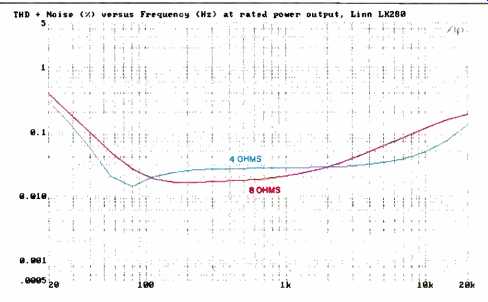
Fig. 3-THD + N vs. frequency at rated output.
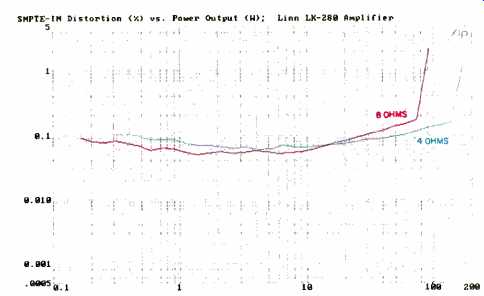
Fig, 4-SMPTE IM vs. power output.
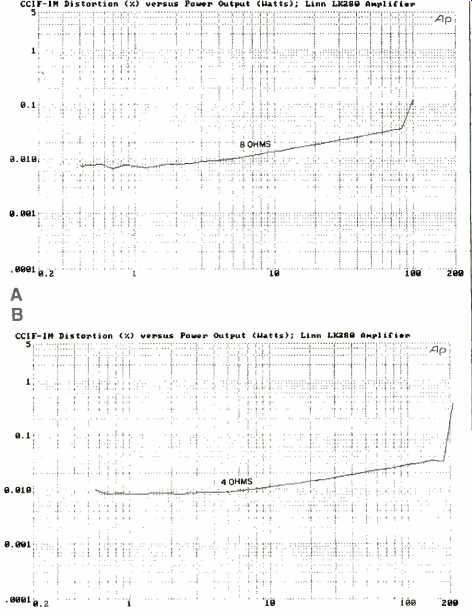
Fig. 5-CCIF-IM (twin-tone) distortion vs. power output for 8-ohm loads (A)
and 4-ohm loads (B).
Damping factor, referred to 8-ohm loads and using a 50-Hz test tone, was in excess of 125. In view of the fact that all tests were made with the LK1/LK280 combination, it was not possible to measure S/N ratio of the power amp alone.
Subsequent listening tests using the two components convinced me that Linn had achieved an extremely low level of residual noise, one that did not intrude at any realizable listening level.
Use and Listening Tests
I am always looking for CDs that will serve well in evaluating new equipment. It was my good fortune to recently acquire a complete set of 16 discs containing all of Gustav
.Mahler's symphonic works plus his monumental "Das Lied von der Erde" ("The Song of the Earth"). These definitive recordings, issued by Denon (CO-72589 to CO-72604), feature the Frankfurt Radio Symphony Orchestra conducted by Eliahu Inbal, and they have been praised by many critics. As a recent convert to Mahler (whose music I neither liked nor understood in my younger years), I have been sitting here, almost as if in a trance, listening to disc after disc played through this wonderful pair of components.
Both the First and Fifth Symphonies--my two favorites sounded so completely open and devoid of electronic artifacts that when I closed my eyes, I almost felt as though I had been transported to the sight of the live performance.
This doesn't happen to me very often, and I must confess that I did not get the same sensation when these recordings were played through what I had previously regarded as a pretty good integrated amplifier which I often use as a reference in my listening room.
The more I do this sort of listening, the more convinced I become that differences in relatively good audio components are most easily perceived when the source material is well recorded and well performed. Play a pedestrian CD through a variety of equipment, and it will sound pretty much the same each time. Play a superb recording like the Denon Mahler releases on a superior component combination such as this Linn system, and you know at once that you are dealing with audio components which are far above the ordinary. Are they worth their price--which is, to say the least, not inexpensive? Are a Rolls-Royce or top-of-the-line Mercedes worth what one has to pay for them? For those few who seek the best in any product category, the answer is a resounding "yes!"
--Leonard Feldman
(Source: Audio magazine, Apr. 1989)
Also see: Linn Axis Turntable (May 1987)
Linn Sondek LP12 Turntable (Nov. 1983)
= = = =